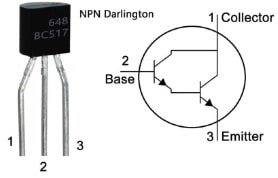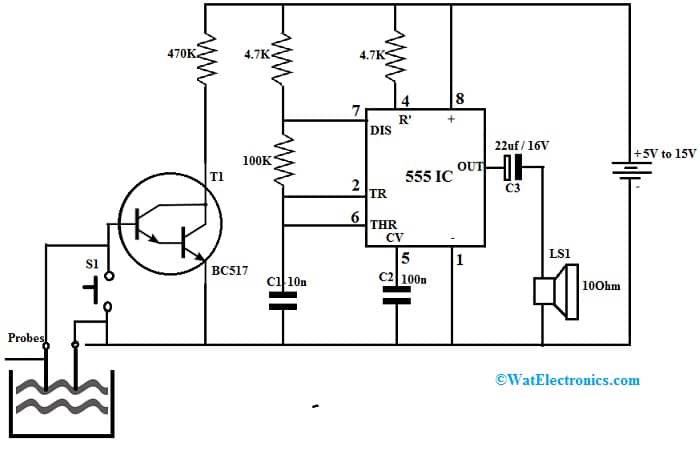Darlington pair is a multi-transistor or Darlington configuration in electronics which includes two BJTs like PNP or NPN. This transistor is named after its inventor name “Sidney Darlington”. It is a special arrangement of two PNP/NPN standard BJTs connected together. The emitter terminal of one transistor is connected to the base terminal of the other transistor so that the flow of current can be amplified through the primary transistor and further, it is amplified by the secondary transistor. In this configuration, both the transistor’s collector terminals are connected together. The current gain of this configuration is much higher as compared to every transistor taken separately. This article provides brief information on one of the Darlington transistors namely the BC517 Darlington transistor, pin configuration, specifications & their applications.
What is BC517 Darlington Transistor?
BC517 is an NPN Darlington transistor, which is normally used for switching or amplifying electronic signals & electrical power. This transistor is made with semiconductor material and it includes three terminals that help in connecting an external circuit. This Darlington transistor is available in the TO-92 package. This transistor is a combination of two transistors either NPN or PNP which are connected in a Darlington pair with each other within a single package to get high gain & also to switch ON maximum current on extremely little base current. The main feature of this transistor is, it drives 1.2A of load at its o/p.
Working
Generally, the base terminal is responsible for transistor action. So when voltage is provided to the base terminal of this transistor then the transistor gets biased. This terminal works like an electron valve that controls the flow of electrons throughout the base terminal. This terminal functions similarly to PNP although it controls the holes flowing throughout it.
The small current in the amplification process at the base terminal can be amplified and generated across the other two terminals of the transistor. Once this transistor functions as a switch, it changes the available small amount of current at one terminal of the transistor to a large amount of current across the other two transistor terminals.
This is an NPN-type transistor, so the base terminal is positive with respect to the emitter terminal. As compared to the voltage at the collector terminal, the voltage at the emitter terminal is less positive. In addition, the collector terminal of the transistor is connected to the resistor to restrict the current flow.
Pin Configuration:
The pin configuration of the BC517 Darlington Transistor is shown below. This transistor contains three terminals which are discussed below.

BC517 Transistor Pin Configuration
- Pin-1 (Collector): This terminal allows the flow of current.
- Pin-2 (Base): This terminal helps in triggering the transistor.
- Pin-3 (Emitter): Current flows out throughout this terminal.
Features & Its Specifications:
The features and specifications of the BC517 Darlington transistor are discussed below.
- BC517 is a Darlington pair NPN transistor.
- This transistor includes three terminals.
- This transistor is manufactured within the TO-92 package which is made with plastic/epoxy material.
- The collector terminal to emitter terminal voltage is 30Volts.
- The collector terminal to base terminal voltage is 40 volts.
- The emitter terminal to base terminal voltage is 10Volts.
- The saturation voltage from the collector terminal to the emitter terminal is 1Volt.
- The collector current of this transistor is 1.2A.
- The power dissipation of this transistor is 625mW.
- The DC current gain of this transistor is 30000Hfe.
- The junction and operating temperature range of this transistor ranges from > -55 to <150℃.
- The thermal resistance of this transistor is 83.3℃/W.
- The transition frequency value of this transistor is around 220MHz.
- The PNP Complementary BC517 transistor is BC516. The equivalent BC517 transistor is MPSW45A and 2N6426.
How to use BC517 Darlington Transistor carefully in a Circuit?
To use the BC517 Darlington transistor very carefully in a circuit for a long time, it is suggested not to operate from above 30V. In any circuit, connect these transistor pins properly, otherwise, it may get damaged. Do not connect any load above 1.2A (1200mA). The minimum & maximum temperature range of this Darlington transistor is > -55 degrees C to +150 degrees C. So do not store or utilize this transistor in these temperature ranges.
Water Leakage Detection Circuit using BC517 Transistor
The water leakage detection circuit using the BC517 transistor is shown below. This circuit mainly uses a 555 timer IC for detecting water leakage in its surroundings and gives an alarm to alert the concerned person before any harm occurs. This circuit is an inexpensive and very effective solution to detect water leaks in offices, homes, etc. By using a reliable 555 timer IC, this circuit detects small amounts of water leaks and gives an alert to the users.
The required components to make this circuit mainly include; a 5V to 15V power supply, 555 IC, BC517 transistor, C1-10n, C2-100n, and C3-22uf / 16V Capacitors, two 10nf capacitors, resistors 100K, 470K and two 4.7K resistors, optional test switch and 10 ohms speaker. Connect the circuit as per the circuit diagram shown below.

Water Leakage Detection Circuit using BC517 Transistor
Working
The water leakage detector circuit generates an audible sound through a speaker whenever its circuit probes detect the water. This circuit can be installed at the washing machine or cellar flooding alarm to give an alarm immediately when water leakage is detected.
Once water leakage is detected, then probes can supply a small amount of current that causes the base potential of the T1 Darlington transistor to be pulled well under 0.6 V. Thus, the voltage at the collector terminal highly swings and lifts the oscillator’s reset condition, which will begin to work. On the other hand, if there is no water then the T1 transistor will keep the 555 timer IC reset.
Here, this IC is used in astable mode, so that it drives a small loudspeaker directly. The alarm sound can be set to about 700Hz frequency through the R1-R3-C1 network & has about 0.5 duty factor. Here, an optional S1 test switch enables this circuit to be checked. Whenever the S1 switch is pressed, the loudspeaker must generate an alarm sound. This circuit’s current drain is about 10 mA whenever no leakage water is detected & about 50 mA whenever the alarm generates sound. So these values can be measured by 6V of voltage supply.
Advantages & Disadvantages
The advantages of this Darlington transistor include the following.
- It provides extremely high current gain as compared to a single transistor.
- It provides high input impedance.
- It is applicable in simple circuit designs.
- It amplifies the signal to a larger level.
- It is very responsive to the current.
The disadvantages of this Darlington transistor include the following.
- When the Darlington pair is in saturation region then voltage drop will be there at the emitter and base terminals.
- It has less switching speed.
- It has limited bandwidth.
- It provides high power dissipation because of high saturation voltage.
- This configuration at certain frequencies introduces a phase shift within a negative feedback circuit.
- The overall leakage of this transistor pair is high.
Applications of BC517 Darlington Transistor
The applications of the BC517 Darlington transistor include the following.
- This Darlington transistor has a high gain so it can be used for amplifying current signals from low gain to high gain.
- This transistor is used in stages wherever there is amplifying low gain signals is necessary like; audio preamplifier stages because it provides very good gain to extremely weak audio signals.
- This transistor is used beside audio circuits to amplify different low-gain signals.
- Whenever this transistor is used as a switch it becomes saturated on an extremely small amount of current.
- This type of transistor drives Relays, LEDs, motors, etc below 1200mA.
- This ideal transistor is used in hobby, commercial & educational electronic circuits.
- This is applicable in sensor circuits, amplifier stages of audio, audio preamplifiers, drive loads below 1.2A, chargers of battery, motor drivers, regulator circuits, multi-vibrator circuits, H-bridge circuits & switching applications.
Please refer to this link for the BC517 NPN Darlington Transistor Datasheet.
Thus, this is an overview of the BC517 NPN Darlington transistor, manufactured with silicon material within the TO-92 package. One significant feature of this transistor is the high amplification factor so this feature makes this transistor unique. This NPN Darlington transistor carries an amplification factor or current gain of approximately 30,000. It drives different loads at its o/p with 1.2A of a small amount of current. Here is a question for you, what is a BC516 transistor?